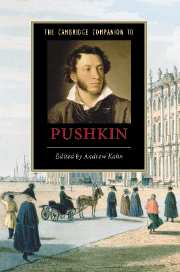Book contents
- Frontmatter
- Introduction
- Part I Texts and Contexts
- 1 Pushkin’s life
- 2 Pushkin’s lyric identities
- 3 Evgenii Onegin
- 4 Pushkin’s drama
- 5 Pushkin’s long poems and the epic impulse
- 6 Prose fiction
- 7 Pushkin and politics
- 8 Pushkin and history
- 9 Pushkin and the art of the letter
- 10 Pushkin and literary criticism
- Part II The Pushkinian tradition
- Appendix on verse-forms
- Guide to further reading
- Index
1 - Pushkin’s life
from Part I - Texts and Contexts
Published online by Cambridge University Press: 28 March 2007
- Frontmatter
- Introduction
- Part I Texts and Contexts
- 1 Pushkin’s life
- 2 Pushkin’s lyric identities
- 3 Evgenii Onegin
- 4 Pushkin’s drama
- 5 Pushkin’s long poems and the epic impulse
- 6 Prose fiction
- 7 Pushkin and politics
- 8 Pushkin and history
- 9 Pushkin and the art of the letter
- 10 Pushkin and literary criticism
- Part II The Pushkinian tradition
- Appendix on verse-forms
- Guide to further reading
- Index
Summary
Alexander Pushkin, like his near-contemporary Lord Byron, took great pride in his aristocratic ancestry. He was born into the family of Sergei L'vovich Pushkin and Nadezhda Osipovna Pushkina née Gannibal, whose ancestors on both sides included prominent figures in Russian history. Through his father, Pushkin belonged to an ancient line of nobility dating back to the twelfth century (not the thirteenth as Pushkin thought); their names are cited twenty-one times in Nikolai Karamzin’s monumental History of the Russian State (1818), the authoritative historical work on Russia in Pushkin’s lifetime. The Pushkin clan stayed close to power up to the end of the sixteenth century, falling from grace under the Romanovs, whose dynasty dates from the early seventeenth century. Several ancestors were conspirators and mutineers and suffered in particular under Peter the Great. By 1799, the year of the poet’s birth, the Pushkin family had lost all their influence and most of their fortune, and, as he grew older, Pushkin came to identify with their lot: 'They were persecuted. And I am persecuted' (PSS, vol. xi, p. 388).
On the maternal side, Pushkin’s great-grandfather, Abram (originally Ibrahim) Petrovich Gannibal was born in Africa in 1696; he may have been the son of an Abyssinian prince, as Pushkin believed. He was sent as a slave to the court of Peter the Great, where he became the tsar’s informal secretary and constant attendant. Eventually he attained the status of hereditary nobleman and was awarded several estates for his loyal service. While Gannibal achieved distinction as a military engineer, a notorious jealous streak marred his private life.
- Type
- Chapter
- Information
- The Cambridge Companion to Pushkin , pp. 11 - 25Publisher: Cambridge University PressPrint publication year: 2006
- 4
- Cited by



